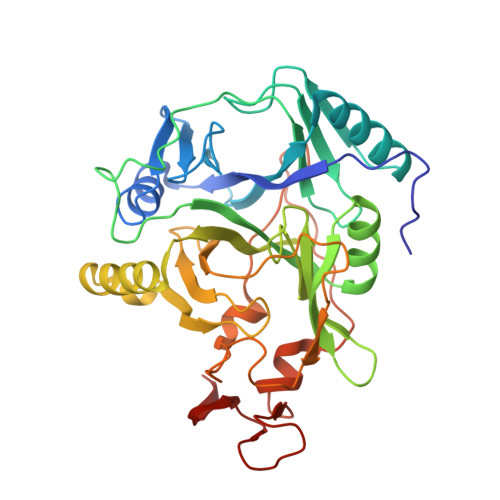Swapping metals in Fe- and Mn-dependent dioxygenases: evidence for oxygen activation without a change in metal redox state.
Emerson, J.P., Kovaleva, E.G., Farquhar, E.R., Lipscomb, J.D., Que, L.(2008) Proc Natl Acad Sci U S A 105: 7347-7352
- PubMed: 18492808
- DOI: https://doi.org/10.1073/pnas.0711179105
- Primary Citation of Related Structures:
3BZA - PubMed Abstract:
Biological O(2) activation often occurs after binding to a reduced metal [e.g., M(II)] in an enzyme active site. Subsequent M(II)-to-O(2) electron transfer results in a reactive M(III)-superoxo species. For the extradiol aromatic ring-cleaving dioxygenases, we have proposed a different model where an electron is transferred from substrate to O(2) via the M(II) center to which they are both bound, thereby obviating the need for an integral change in metal redox state. This model is tested by using homoprotocatechuate 2,3-dioxygenases from Brevibacterium fuscum (Fe-HPCD) and Arthrobacter globiformis (Mn-MndD) that share high sequence identity and very similar structures. Despite these similarities, Fe-HPCD binds Fe(II) whereas Mn-MndD incorporates Mn(II). Methods are described to incorporate the nonphysiological metal into each enzyme (Mn-HPCD and Fe-MndD). The x-ray crystal structure of Mn-HPCD at 1.7 A is found to be indistinguishable from that of Fe-HPCD, while EPR studies show that the Mn(II) sites of Mn-MndD and Mn-HPCD, and the Fe(II) sites of the NO complexes of Fe-HPCD and Fe-MndD, are very similar. The uniform metal site structures of these enzymes suggest that extradiol dioxygenases cannot differentially compensate for the 0.7-V gap in the redox potentials of free iron and manganese. Nonetheless, all four enzymes exhibit nearly the same K(M) and V(max) values. These enzymes constitute an unusual pair of metallo-oxygenases that remain fully active after a metal swap, implicating a different way by which metals are used to promote oxygen activation without an integral change in metal redox state.
Organizational Affiliation:
Department of Chemistry, Center for Metals in Biocatalysis, University of Minnesota, Minneapolis, MN 55455, USA.


















